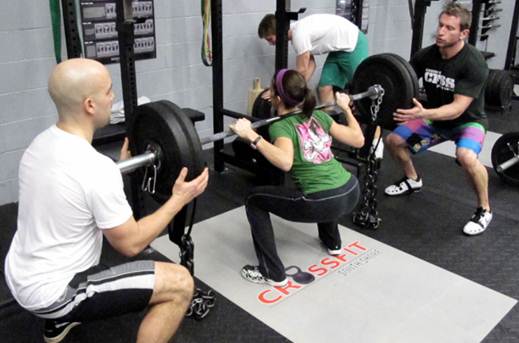5.
Hurdle: “I can’t afford it”

“People
often say they can’t afford gym or sports club fees and personal trainers, and
it’s a reality for many,” says Dr. Van Niekerk. But
for some it’s just an excuse.
Leap it
If you
really can’t afford to join a gym, think about exercise as something to do
anywhere. “Then even walking to the taxi rank is a planned moment to work out,”
Dr. Van Niekerk says.
Get
outdoors, urges Cassim: “Get running, surfing,
rafting or any fun activity that gets muscles working!”
Home
workouts can also be effective, using rubber bands for resistance, lifting
weights or plastic bottles filled with sand or water, doing lunges, squats and
pushups, and skipping rope, walking or jogging. All you need pay for is good
shoes. (See shapemag.co.za for workouts.)
Team up
with a buddy for motivation, and share a personal-trainer session at the start
to establish a routine and sound technique. But if you can afford a club or
instructors, consider it an investment as important as health insurance or a
work training course, says Venter: “Think of the savings in medication and
doctors’ fees!”
6.
Hurdle: “I get bored”

This is a
major cause of people dropping out of exercise, reports Venter. Habit forms
after three weeks and holds us for a period. But if we lose interest or stop,
usually for travel, illness or to have a baby, we struggle to go back.
Leap it
“Gym is
like marriage; if you want it to last you have to keep it fresh, be dedicated,
and use willpower to stick through the tough times,” says Cassim.
Choose something you enjoy, and build variety into your routine.
Change
squash partners and courts, run different routes, and set yourself goals that
encourage you to progress – join a league, enter fun races. “Cross-train: gym
one day for weight training, cycle or run for cardio the next,” adds Venter.
And don’t underestimate the power of rousing music on an iPod.
7.
Hurdle: “I don’t see any results”

If you
start with a goal of losing a certain number of kilos and struggle to achieve
it, it’s easy to get disheartened when you don’t achieve it fast, and drop out,
says Venter.
Leap it
“Reassess
your training programme and eating,” says Cassim. Set your goal in centimetres
not kilos, as exercise builds muscle while burning fat and can leave you
heavier though leaner and more sculpted. Rather monitor your success by the way
clothes fit.
“Better
yet, make your motivation a healthier lifestyle,” says Dr. Van Neikerk. Focus on improvements in your endurance, strength,
blood pressure and cholesterol levels. Also be sure to learn the right
techniques – you can waste time doing sets that don’t bring results. Have a
plan of progression, increasing weights, distance and intensity, says Cassim.
“Do
compound exercises that require you to use major muscle groups, burning more
kilojoules,” she advises. “Invest in a pedometer or heart-rate monitor to keep
track of your progress,” says Venter.
8.
Hurdle: “I’ve tried before and I can’t keep up the rountine”

This I no
reason not to try again, says Cassim. You were
probably not doing the right exercise for you, in the right way.
Leap it
The key is
to set yourself realistic routines you can stick to. Pace yourself (start
gently), and eat properly to fuel your workouts. You need plenty of fresh
vegetables and fruits, enough protein, healthy omega oils and fibre, and lots of water. Most importantly, Cassim says, “Have goals you can achieve, and reward
yourself when you do with something like a massage or weekend away.”
9.
Hurdle: “I’m just not athletic”

It’s a
common claim, but you don’t need to be athletic – you just need to be able to
move for 40 to 60 minutes a day, five or six times a week, says Cassim.
Leap it
“Staring
with 20 minutes three times a week is enough for you to enjoy both physical and
psychological health benefits, and encourage you to do more,” advises Dr. Van Niekerk. “Try a basic routine like a daily walk.”
10. Hurdle: “I’m lazy!”

This is the
second most reported reason not to exercise.
Leap it
“Lazy
people graze,” says Cassim. “Remind yourself that the
more you sit on the couch, the more likely you are to consume unwanted kJ, so
get moving!”
Remind
yourself of the benefits of exercise and find something that excites you. The
choice is wide, from Zumba to kick-boxing, Crossfit and t’ai chi. Plan it
for a time when you’re energetic and team up with someone: “If a girlfriend or
boyfriend is exercising,” says Dr. Van Niekerk, “the
lazy get going!”
Boost your motivation
1. Set “smart” goals, says sports psychologist Dr. Leon van Niekerk: specific, measurable, achievable, realistic, with a timeline. “They should also be challenging
and joyful.”
2. Write your goals on cards and stick them to your computer,
mirror and fridge, plus pictures of your current and future self.
3. Commit by joining a club or trainer, getting the
gear, and telling friends for motivational social support.
4. Get good advice from a trainer to make sure you’re doing the
right exercise the right way to achieve your goals.
5. Measure frequently, and readjust your goals accordingly, Dr. Van Niekerk says. “Sometimes you will have to readjust
downloads to build your confidence again.”